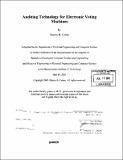Auditing technology for electronic voting machines
Author(s)
Cohen, Sharon B
DownloadFull printable version (9.132Mb)
Alternative title
voter verification audio audit transcript trail
Other Contributors
Massachusetts Institute of Technology. Dept. of Electrical Engineering and Computer Science.
Advisor
Ted Selker.
Terms of use
Metadata
Show full item recordAbstract
Direct Recording Electronic (DRE) voting machine security has been a significant topic of contention ever since Diebold voting machine code turned up on a public Internet site in 2003 and computer scientists at Johns Hopkins University declared the machine "unsuitable for use in a general election." Since then, many people from computer scientists to politicians have begun to insist that DREs be equipped with a paper trail. A paper trail provides a paper printout for the voter to approve at the end of each voting session. Although there have been strong political efforts to place paper trails on DRE machines, there have not been any scientific studies to indicate that paper trails are effective audits. This work describes a user study done to compare paper trails to audio audits, a new proposal for DRE auditing. Participants in the study completed four elections on a voting machine with a paper trail and four elections on a machine with an audio trail. There were purposeful mistakes inserted into the audits on some of the machines. Results from the study indicated that participants were able to find almost 10 times as many errors in the audio audit then they were able to find in the paper trail. Voters' attitudes towards the paper audit were extremely apathetic, and voters did not spend much time reviewing their paper record. When asked which type of audit voters would prefer for their own county elections, almost all voters preferred the VVPAT. These results indicate that newer alternative audit technology holds great promise in delivering a safe and accurate audit and further that paper trails have some significant design obstacles that need to be overcome before they will be effective audits.
Description
Thesis (M. Eng. and S.B.)--Massachusetts Institute of Technology, Dept. of Electrical Engineering and Computer Science, 2005. Includes bibliographical references (leaf 63).
Date issued
2005Department
Massachusetts Institute of Technology. Department of Electrical Engineering and Computer SciencePublisher
Massachusetts Institute of Technology
Keywords
Electrical Engineering and Computer Science.